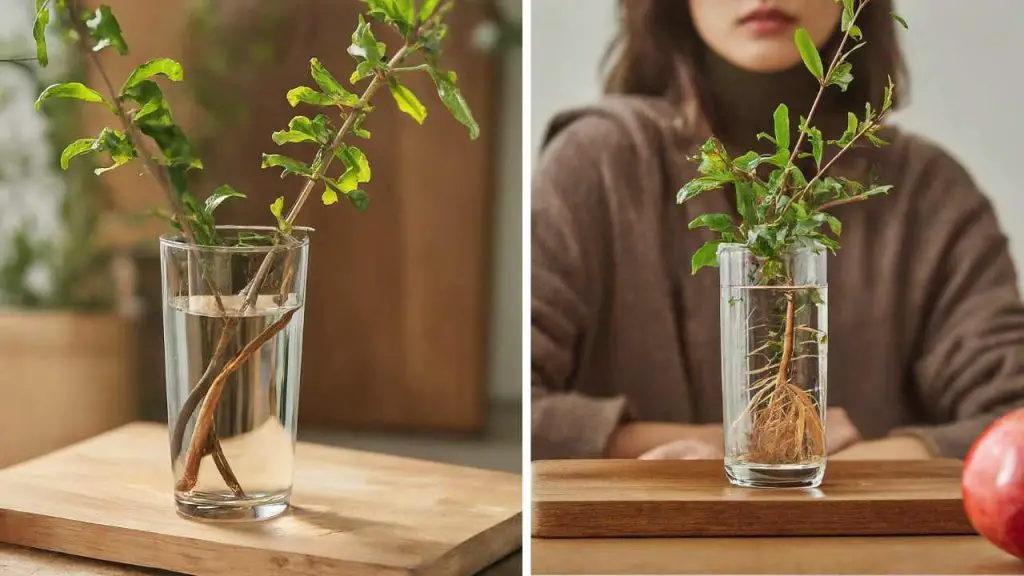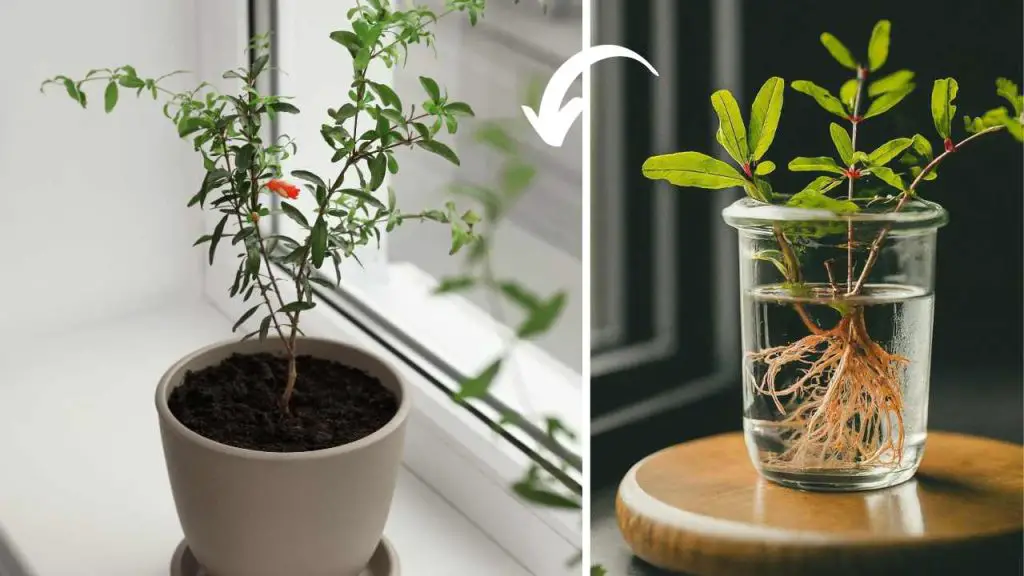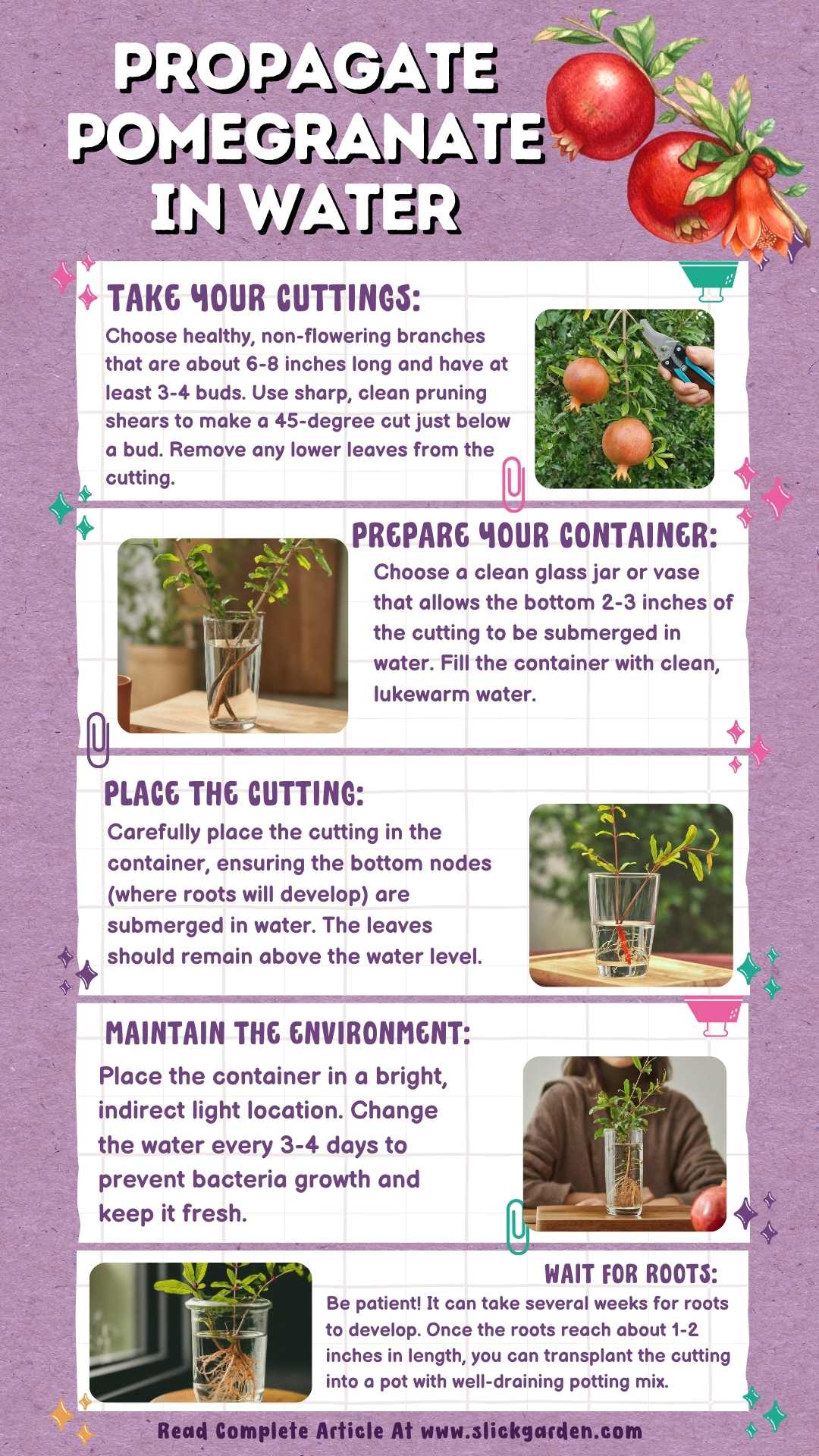Pomegranates preferred to grow in hot and dry climates. You must plant it in well-drained soil in a sunny area for better results. You can easily propagate pomegranate by seeds or cuttings.
Both methods are best for growing this ornamental fruiting plant that produces jewel-tone fruits.

Propagation of pomegranate by cutting is best when you want to grow the plant exactly like the parent plant.
This method is very economical as you have to spend nothing just cutting from your favourite pomegranate plant and rooting it in water.
When To Take Cuttings Of Pomegranate?
The ideal temperature for the rooting of the cuttings of pomegranate is 20 degrees Centigrade or 68 degrees Fahrenheit. It is better to take cuttings in the morning and use these cuttings for propagation purposes as soon as possible.
You should choose semi-hardwood cuttings because they are easier to root than softwood cuttings. If you choose softwood cuttings they need special care and do not root well.
You should refrain from taking old and young branches as they will not root well. It is best to choose cuttings from the previous year’s growth.
How To Propagate Through Cuttings In Water Step By Step?

When you grow pomegranate from cuttings then your plant will start producing flowers and fruit in less time which is not possible when you start this attractive tree from seed. Things you need when you grow pomegranate from cuttings.
- A sharp pruning shear
- A glass vase
- Healthy cuttings from pomegranate tree
Following are the simple and easy steps if you follow them you will be succeeded by growing an identical plant that resembles its parent plant.
Step 1: Selection Of Pomegranate Plant For Taking Cuttings
You should be careful when choosing the plant from which you are taking cuttings for propagation. Make sure this plant is healthy and mature so the cuttings will turn into a healthy plant that produces juicy treats for you.
One thing you should keep in mind is that this plant must be disease-resistant and produce excellent-quality fruit. If you find such a tree with all the above characteristics, you can choose it. If you find any signs of pests or diseases, you should not take cuttings from such parent plants.
Step 2: Choosing Cuttings From Selected Parent Tree
Make sure you are selecting healthy branches that have thickness just like a pencil. Make sure these cuttings are 6 to 8 inches long and they have 3 to 4 nodes.
Nodes are very important because these are the points where leaves, branches, and roots can grow easily. Ensure cuttings are oriented upright as they can easily remain above the soil.
STEP 3: PREPARING CUTTINGS FOR ROOTING
For taking branches from your selected healthy pomegranate plants, you need a sharp and sterile knife. Your cut must be clean and it is below a leaf node.
If there are any leaves or flower buds on the cuttings remove them from the lower part as this part of the cutting will grow tiny roots. Removing leaves or flower buds also helps the new plant to use all of its energy in the rooting process.
STEP 4: PUT THE CUTTINGS IN THE VASE AND WAIT FOR THE GROWTH OF NEW ROOTS
To encourage the rooting process, you can dip the branches in the rooting hormone. Rooting hormone is used to speed the process of rooting and help to encourage a strong root system.
But when you are propagating cuttings in water then it is suggested that you must not use rooting hormone because it will wash away in the water and not give you the expected results.
Now put those cuttings in the vase that is made from glass. Fill the vase with water. You can easily examine the roots of the cuttings when they are in the glass vase.
It is advised that you should change the water regularly to avoid molding. You should not lose your heart if some cuttings do not root despite your best endeavours.
You should show patience and provide essential care for pomegranate cuttings to thrive. Generally, you can see the growth of roots within 3 to 8 weeks.
STEP 5: TRANSPLANTING OF ROOTED CUTTINGS
When you see the root system is strong enough then you can transplant them in the container or their permanent location. It is not good to keep the cuttings in the soil after rooting because they will not get enough nutrients from the water and they need soil as a growing medium.
The newly planted cuttings need water. The fish and moisture help the roots become stronger and encourage growth. The young newly planted cuttings need water daily. The moisture helps to grow new leaves and settle cuttings in its new home.
Related Article:
- What Trees Can Be Grown From Cuttings? 20 Fruit Trees To Grow From Cuttings
- How To Grow Rosemary From Cuttings In Water?
- List Of Fruit Trees That Grow From Cuttings In Water

What Type Of Soil And Growing Conditions Are Ideal For Pomegranate Cuttings?
The vibrant flowers and delicious fruit of pomegranate trees will add beauty to your garden. When you provide high-quality soil and suitable growing conditions to this tree then it will produce antioxidant-rich fruit for you.
Following are the ideal growing conditions and type of soil that is needed by pomegranate cuttings to adjust to the new environment.
SOIL TYPE
Soil is an important factor because your plants will attain their nutrients from the soil. When you are growing your plants in a pot or a container you can fill it with high-quality potting mix because it contains all the essential organic material that is needed by your pomegranate plants.
If you are transplanting your rooted cuttings directly in the permanent location of your garden then you can make your soil richer by the application of any suitable fertilizer manure or compost.
Make sure the soil of your garden has a pH between 5.5 and 7.5. In case, there is clay soil in your garden then you have to add amendments to improve its quality. Clay-heavy soil is not ideal for growing any plant because it can retain too much moisture that causes roots.
SOIL PREPARATION
When you are growing pomegranate cuttings directly in the garden then before transplanting prepare the soil. First, you should remove weeds or grass from your selected location.
After clearing the ground you can use a garden fork or tiller to till the soil up to 12 inches deep. Tilling will improve the aeration and drainage of the soil.
In case, the soil of your garden is heavy then you should also add organic matter like manure or compost. It will help in the improving texture of the soil.
SUNLIGHT
Sunlight is very important in the growth of pomegranate plants. You must choose a sunny location where your plants have at least 6 to 8 hours of sunlight to produce high-quality fruit for you.
TEMPERATURE AND CLIMATE
The hot and dry climate is perfect for growing pomegranates. It can also adjust in mild and cool winters. If you want to grow it in a colder climate then you have to provide necessary production to keep the soil warm.
You can apply a layer of mulch around the base of the pomegranate tree to keep the soil moist during the cold months to protect the roots from damage.
WATER
The roots of newly planted pomegranate plants need moisture to establish in a new place. You should water the cuttings deeply so they can’t feel dry.
It doesn’t mean that you over-water the plant because too much moisture becomes the reason for root rot which is not good for your plants.
Important Factors That Influence Pomegranate Plants To Start Producing Fruit
Pomegranate plants produce delicious fruits. After transplanting the cuttings in the soil the next question comes to mind when this nutritious fruiting plant starts producing fruit.
We can’t exactly tell how long a pomegranate plant takes to produce fruit because it depends on several factors. Generally, propagated pomegranate plants start producing fruit within 2 to 5 years.
When plants start producing fruit then it will take a few months to ripen. Generally, late summer or early fall is the time when pomegranate plants produce fruit. Following are some important factors that influence the pomegranate plant to start producing fruit.
VARIETY
When you are choosing a variety for growing in your garden then you must Do some research because some varieties start producing roots earlier on the other hand some will take a long time.
It means different varieties of pomegranate exhibit different fruiting characteristics. It is better to choose a quick fruiting variety for a quick start.
AGE OF THE PLANT
The age of the plant is very important when you are taking cuttings for propagating purposes from a pomegranate plant. If your plant is young then it will take time to produce fruit and the order will start producing food earlier.
GROWING CONDITIONS
A hot and dry climate is perfect for growing pomegranate trees. When your fruiting trees get full sun exposure they will produce a higher yield of fruits.
The shaded area is not good for fruiting plants because if they don’t receive enough light their growth will be disturbed and take time to bear fruit.
When you are selecting the location of your pomegranate cuttings then you must choose a spot where young plants receive at least 6 to 8 hours of direct sunlight.
Water is another important factor that plays a very important role in the fastest growth of pomegranate plants. Make a schedule for watering in hot weather. Plants need more water in hot summer than in winter.
Make sure you are using well-drained soil for growing pomegranate plants because poor soil can become the reason for spreading many fungal diseases.
Related Article:
- What Trees Can Be Grown From Cuttings? 20 Fruit Trees To Grow From Cuttings
- How To Grow Rosemary From Cuttings In Water?
- List Of Fruit Trees That Grow From Cuttings In Water
PRUNING AND CARE
When your pomegranate plants start producing fruit then it is time when they need proper care and attention. At this stage, you should focus on pruning the plant to give it proper shape and encourage more fruiting.
When winter comes it is suggested that you must prune it to promote new growth and discard dead or diseased parts of the plants.
When you provide water on time, feed the plants by using suitable fertilizer or compost, and control the population of pests then no doubt your plants will produce fruits according to need.
Weeds can become a problem for your plants because they steal nutrients from the soil. You can control them by applying a layer of mulch.
